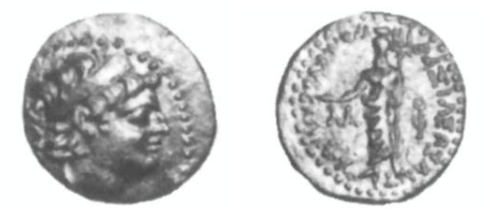S 132 - Berytus / Laodicea in Phoenicia, bronze, Module 1 (system of 4 modules), 117-113 BC
From SILVER
117 BCE - 113 BCE Bronze
Description
| ObverseInscription or printing placed on the obverse.: | Head of Antiochus VIII right, wearing a diadem. (In the left field, A.) Border of dots. |
| ReverseInscription or printing placed on the reverse.: | ΒΑΣΙΛΕΩΣ ANTIOXOY and "To Laodicea mother of Canaan" (Greek and Phoenician).Baal Bérytos facing, wearing a flat tiara and an himation, holding a patera in the right hand and a trident in the left hand. In the field, ΛΑ-Φ (et un aplustre.) Border of dots. |
Mint and issuing power
| MintIdentifies the place of manufacture or issue of a numismatic object.: | Berytus / Laodicea in Phoenicia | Ancient regionAncient region.: | Syria (Phoenicia) | Modern countryModern country: Lebanon | AuthorityIdentifies the issuing power. The authority can be "pretended" when the name or the portrait of X is on the coin but he/she was not the issuing power. It can also be "uncertain" when there is no mention of X on the coin but he/she was the issuing power according to the historical sources: | Antiochus VIII Grypus (Seleucid king, 121/0-97/6 BC), Seleucid Dynasty (312-63 BC) |
Chronology
| FromIdentifies the initial date in a range assigned in a numismatic context. | 117 BCE | toIdentifies the final date in a range assigned in a numismatic context.. | 113 BCE | PeriodTime period of the numismatic object.: Hellenistic 323-30 BC |
Physical description
| MetalThe physical material (usually metal) from which an object is made.: | Bronze |
Median weightMedian of the weights of numismatic objects (in grams). in grams | 4.50 | DenominationTerm indicating the value of a numismatic object. Examples: tetradrachm, chalkous, denarius.: | Module 1 (system of 4 modules) | StandardStandard.: |
References
| Die study referencePublication of the study: | Sawaya 20041Sawaya 2004, p. 109-146, pl. 10-18 (p. 143, no. 179-183). | ||
| Coin series referenceReference to coin series study: | |||
Obverse dies distribution
| FrequencyFrequency of specimen in distribution. ᵖ | Number of obversesNumber of obverse dies. ᵖ (o) | % (o) | Number of coinsNumber of coins. (n) | % (n) | Die nameName(s) of the die(s). |
| 1 | 2 | 66.67 | 2 | 40 | D1 (no issue mark), D2 (A) |
| 3 | 1 | 33.33 | 3 | 60 | D1 (A) |
| Total | 3 of 3 | 100 | 5 of 5 | 100 |
Reverse dies distribution
no distribution is available
Quantification
| Number of obversesNumber of obverse dies. ᵖ (o) | 3 | Number of singletons (o1)The number of singleton coins. ᵖ | 2 |
| Number of reverse diesNumber of reverse dies. (r) | 5 | Number of coinsNumber of coins. (n) | 5 |
| Coins per obverse dieNumber of coins per obverse die. (n/o) | 1.67 | Coins per reverse dieNumber of coins per reverse die. (n/r) | 1 |
| Reverse per obverse ratioRatio of obverse dies divided by reverse dies. (r/o) | 1.67 | Percentage of singletons (o1)number of coins (n) divided by the number of singletons (o1) ᵖ | 66.67 % |
| Original number of dies (O) (Carter 1983 formula)The estimation of the number of coins according to Carter 1983 ᵖ | 6.05 | Coins struck if 20,000 as average productivity per dieCoins made if the average productivity for obverses (according to Carter) is 20,000. ᵖ | 121,000 |
| Original number of dies (O) (Esty 2011 formula)The estimation of the number of coins according to the singleton formula in Esty 2011 ᵖ (O) | 7.5 | Survival rate if 20,000 as average productivity per dieSurvival rate if average productivity is 20,000. ᵖ | 0.00004 |
| Coverage (o = % of O) (Esty 1984 formula)Esty 1984 - coverage (% of O) ᵖ (o = % of O) | 60% | Die productivity if survival rate 1/2,000Average productivity if survival rate is 1/2,000. ᵖ | 1,652.89 |
| Weight of silver (in kg) if 20,000 coins per die (O = Carter formula)Carter 1983 * Median weight * 20000 (*10 if gold or electrum) ᵖ | n.a. | Die productivity if survival rate 1/5,000Average productivity if survival rate is 1/5,000. ᵖ | 4,132.23 |
Remarks
References
- ^ Sawaya, Ziad (2004) "Le Monnayage Municipal Séleucide de Bérytos (169/8-114/3 ? av. J.-C.)", Numismatic Chronicle 164, p. 109-146, pl. 10-18.
